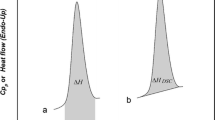Abstract
Crystal melting behavior of indium and isotactic polypropylene has been examined by differential scanning calorimetry of heat flux type in terms of the heating rate, \(\beta \), dependence. The melting shows the dependence characterized by a power, \(z\), of the shift in peak temperature in proportion to \(\beta ^{\text{z}}\). The power, \(z\), differentiates the melting with and without superheating. For polymer crystal melting, intrinsic nature of the broad melting region with a fractional power, \(z\,\le\,1/2\), due to superheating of melting kinetics has been reconfirmed experimentally. On the other hand, the crystal melting of indium, which is supposed to proceed with negligible superheating, showed the shift in peak temperature with the power in the range of \(1/2\,\le\,z \le\,1\), depending on sample mass, which is due to instrumental thermal lag predicted by the Mraw’s model consisting of lumped elements. The \(\beta \) dependence is influenced by the thermal lag determined by the thermal contact resistance between the sample pan and the stage, the effect of which has been examined in terms of the dependence on sample mass and the application of silicone grease between the sample pan and the stage. The influence of two different types of the definition of heat flow has also been examined; the simplified one without the time derivative of temperature difference showed an apparent shift in peak temperature at faster scan rates in a similar way as that of thermal lag.
















Similar content being viewed by others
References
Wunderlich B. Macromolecular physics, vol. 3. New York: Academic Press; 1976.
Schawe JEK, Strobl GR. Superheating effects during the melting of crystallites of syndiotactic polypropylene analysed by temperature-modulated differential scanning calorimetry. Polymer. 1998;39:3745.
Sohn S, Alizadeh A, Marand H. On the multiple melting behavior of bisphenol-a polycarbonate. Polymer. 2000;41:8879.
Toda A, Yamada K, Hikosaka M. Superheating of the melting kinetics in polymer crystals: a possible nucleation mechanism. Polymer. 2002;43:1667.
Yamada K, Hikosaka M, Toda A, Yamazaki S, Tagashira K. Equilibrium melting temperature of isotactic polypropylene with high tacticity. 2. Determination by optical microscopy. Macromolecules. 2003;36:4802.
Toda A, Kojima I, Hikosaka M. Melting kinetics of polymer crystals with an entropic barrier. Macromolecules. 2008;41:120.
Pandey A, Toda A, Rastogi S. Influence of amorphous component on melting of semi-crystalline polymers. Macromolecules. 2011;44:8042.
Toda A, Taguchi K, Sato K, Nozaki K, Maruyama M, Tagashira K, Konishi M. Melting kinetics of it-polypropylene crystals over wide heating rates. J Therm Anal Calorim. 2013;113:1231.
Toda A, Taguchi K, Nozaki K, Konishi M. Melting behaviors of polyethylene crystals: an application of fast-scan DSC. Polymer. 2014;55:3186.
Schawe JEK. Analysis of non-isothermal crystallization during cooling and reorganization during heating of isotactic polypropylene by fast scanning DSC. Thermochim Acta. 2015;603:85.
Minakov AA, Wurm A, Schick C. Superheating in linear polymers studied by ultrafast nanocalorimetry. Eur Phys J E. 2007;23:43.
Gao H, Wang J, Schick C, Toda A, Zhou D, Hu W. Combining fast-scan chip-calorimeter with molecular simulations to investigate superheating behaviors of lamellar polymer crystals. Polymer. 2014;55:4307.
Poel GV, Mathot VBF. High-speed/high performance differential scanning calorimetry (HPer DSC): temperature calibration in the heating and cooling mode and minimization of thermal lag. Thermochim Acta. 2006;446:41.
Illers K-H. Die ermittlung des schmelzpunktes von kristallinen polymeren mittels warmeflusskalorimetrie (DSC). Eur Polym J. 1974;10:911.
Danley RL. New heat flux DSC measurement technique. Thermochim Acta. 2003;395:201.
Mraw SC. Mathematical treatment of heat flow in differential scanning calorimetry and differential thermal analysis instruments. Rev Sci Instrum. 1982;53:228.
Minakov AA, Adamovsky SA, Schick C. Non-adiabatic thin-film (chip) nanocalorimetry. Thermochim Acta. 2005;432:177.
Minakov AA, Schick C. Ultrafast thermal processing and nanocalorimetry at heating and cooling rates up to 1MK/s. Rev Sci Instrum. 2007;78:073902.
Chen W, Zhou D, Xue G, Schick C. Chip calorimetry for fast cooling and thin films: a review. Front Chem Chin. 2009;4:229.
Mathot V, Pyda M, Pijpers T, Poel GV, van de Kerkhof E, van Herwaardeng S, van Herwaardeng F, Leenaers A. The flash DSC 1, a power compensation twin-type, chip-based fast scanning calorimeter (FSC): first findings on polymers. Thermochim Acta. 2011;522:36.
van Herwaarden S, Iervolino E, van Herwaarden F, Wijffels T, Leenaers A, Mathot V. Design, performance and analysis of thermal lag of the UFS1 twin-calorimeter chip for fast scanning calorimetry using the Mettler-Toledo Flash DSC 1. Thermochim Acta. 2011;522:46.
Iervolino E, van Herwaarden AW, van Herwaarden FG, van de Kerkhof E, van Grinsven PPW, Leenaers ACHI, Mathot VBF, Sarro PM. Temperature calibration and electrical characterization of the differential scanning calorimeter chip UFS1 for the Mettler-Toledo Flash DSC 1. Thermochim Acta. 2011;522:53.
Hatta I, Muramatsu S. High precision heat capacity measurement by dynamic differential scanning calorimetry. Jpn J Appl Phys. 1996;35:L858.
Saito Y, Saito K, Atake T. Theoretical analysis of heat-flux differential scanning calorimetry based on a general model. Thermochim Acta. 1986;99:299.
Toda A, Konishi M. An evaluation of thermal lags of fast-scan microchip DSC with polymer film samples. Thermochim Acta. 2014;589:262.
Young Y. Physical properties of polymers handbook. New York: AIP Press; 1996.
Toda A, Hikosaka M. Full deconvolution of the instrumental coefficients in scanning calorimeter of heat flux type. Thermochim Acta. 2005;436:15.
Gosh RC, Tanaka S, Toda A. Application of a deconvolution method to construct aqueous phase diagram. Thermochim Acta. 2010;500:100.
Acknowledgements
The author wishes to thank Dr. K. Tagashira (Sun Allomer Ltd.) for providing isotactic polypropylene.
Author information
Authors and Affiliations
Corresponding author
Appendices
Appendix 1: The onset and peak temperatures of melting without superheating measured by DSC of an ideal power compensation type
For DSC of an ideal power compensation type, the temperatures at the monitoring stages will be perfectly controlled at a programmed value to be \(T_{\text{m}}=T_{\text{mr}}=T_{\text{h}}\) with the heat flow, \(\dot{Q}_{\text{s}}\) of Eq. (10) and \(\dot{Q}_{\text{r}}\) of Eq. (11), to each cell and hence with the excess heat flow, \(\dot{Q}\) of Eq. (12). As pointed out by Mraw [16], the DSC of power compensation type can be regarded as a limiting case of \(K_{0} \rightarrow \infty \) of the model and analysis given above, and hence, from the above discussions,
Then, for \(x^{\text{peak}} \gg 2 C_{\text{s}}/K_{1}\) (\(\beta \ll K_{1} \Delta H_{\text{f}}/C_{\text{s}}^{\,2}\)),
Equation (43) corresponds to the expression of the square root dependence of Illers’s analysis [14], in which the temperature shift was measured from the onset temperature, \(T_{\text{m}}^{\text{onset}}\), of Eq. (41), so that the shift, \(T_{\text{m}}^{\text{peak}}-T_{\text{m}}^{\text{onset}}\), was directly proportional to \(\beta ^{1/2}\). For the DSC of power compensation type, detailed experimental examinations of the onset and peak temperatures of standard materials have been discussed by Poel and Mathot [13]. Though the truly square root dependence is for the shift, \(T_{\text{m}}^{\text{peak}}-T_{\text{m}}^{\text{onset}}\), there can be practically no difference between the dependences of the shift and the peak temperature itself for the case that the square root dependence is the leading term in Eq. (43).
For \(x^{\text{peak}} \ll 2 C_{\text{s}}/K_{1}\) (\(\beta \gg K_{1} \Delta H_{\text{f}}/C_{\text{s}}^{\,2}\)),
In this way, the heating rate dependences of the onset and peak temperatures of Eqs. (41), (43) and (44) are similar to those of heat flux type, Eqs. (23), (29) and (31), respectively.
Appendix 2: Numerical calculation for the melting with the superheating of kinetics and without the distribution of melting point
It is conceivable that a pure material without the distribution of melting point undergoes superheating of melting kinetics; melting of organic materials can be the case, as has been pointed out by Wunderlich [1]. In that case, sample temperature will not be kept constant at \(T_{\text{Melt}}\) anymore, so that the analytical treatments given above are not applicable. The melting behavior is numerically examined in this appendix. By utilizing the same model as that for indium and polymer crystal melting, we set the same parameters as those of indium other than the kinetic parameters of \(y=4\) and \(a=3\,\times \,10^{-4}\) which are the same as those of polymer crystal melting. Temperature gradient in the sample was not considered for simplicity. Figure 17 shows the case of small mass, with which thermal lag had negligible influence. Melting peak shifts to higher temperature with faster heating rate, and the \(\beta \) dependence is characterized by the power of \(z=0.2\) expected from the preset power of \(y=4\). The peak temperature does not correspond to the completion of melting, but nearly corresponds to the time of half melting, \(\varPhi =0.5\); the behavior is totally different from that of indium melting without superheating and similar to the case of iPP melting with superheating. As seen in Fig. 17c, the onset temperature also followed the same power of \(z=0.2\). It is noted that, with larger mass, thermal lag is superposed and the peak temperature shifts to higher temperature at fast heating rates, as was the case of iPP melting.
Numerical calculation results of melting with superheating and without melting point distribution. In (a), thick lines represent the heat flow on melting in \(\dot{Q}\) and thin lines the untransformed fraction, \(\varPhi \). In (b) and (c), the symbols represent the following temperatures of \(\dot{Q}\) with grease (\(K_1/K_0=6\)): peak temperature (filled circle), onset temperature (filled triangle), and \(T_{\text{m}}\) at \(\varPhi =0.5\) (\(\mathbf{+}\)). Thick lines in (b) and (c) represent the expected dependence of \(T_{\text{peak}}-T_{\text{Melt}}=7\,\beta ^{0.2}\). The sample mass was 2 mg
Rights and permissions
About this article
Cite this article
Toda, A. Heating rate dependence of melting peak temperature examined by DSC of heat flux type. J Therm Anal Calorim 123, 1795–1808 (2016). https://doi.org/10.1007/s10973-015-4603-3
Received:
Accepted:
Published:
Issue Date:
DOI: https://doi.org/10.1007/s10973-015-4603-3





